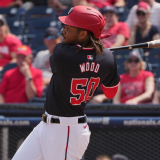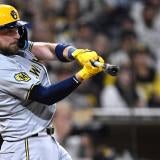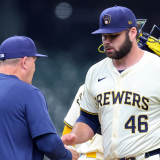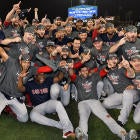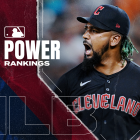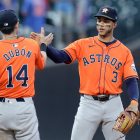In the moment that they jumped on each other in the middle of Dodger Stadium's bright-green infield, no Red Sox player gave any thought to legacy. You dream of winning the World Series when you're seven years old. If you're ever fortunate enough to realize that dream, you celebrate like you're seven years old.
But Boston's World Series victory over the Dodgers in five games marked more than the culmination of a great season. This is the pinnacle moment for one of baseball's most storied franchises. Never before had the Sox ever won as many as 108 games in a season. Never before had they celebrated a third straight division (or league) title. In winning their fourth World Series in 15 years, the Sox have established themselves as the best team of their era, with that era stretching from Curt Schilling's last big year to the start of big things for Andrew Benintendi.
With recent World Series winners including the tiny-market Kansas City Royals and recently moribund Chicago Cubs and Houston Astros, Major League Baseball has seen plenty of parity over the past couple decades. With those four World Series rings in hand, and major variance from year to year within the sport, it's not a stretch to call the Red Sox of the past decade and a half ... a dynasty.
What you don't usually see within a dynasty is a stretch of losing baseball. Yet that's exactly what Boston offered from 2010 to 2015. In that span of six seasons, the Sox made the playoffs just once. Granted, that one playoff berth netted a World Series crown, but the stretch featured two third-place finishes and three last-place finishes. It also produced the foundation for the world-beating juggernaut that blazed its way through the 2018 postseason. The foundation of that foundation was the 2011 amateur draft.
A year after capping a three-year run in which they won no fewer than 95 games each time, the 2010 Red Sox were still a competitive ballclub. They won 89 games, only to narrowly miss the playoffs. Since draft order goes in reverse order of standings, the Sox under normal circumstances might not have looked all that well primed for the 2011 draft. But Boston did something atypical for the franchise that winter, letting multiple premium players bolt for free agency.
The result? Four picks in the first 40 slots of the draft, the kind of bounty typically reserved for cash-strapped teams forced to wave goodbye to key veterans because they can't afford them. All four of those first four selections would go on to make the big leagues with the Sox.
The first of that big four was Matt Barnes, a hard-throwing right-hander who was also a relative local, playing both his high-school and college ball in neighboring Connecticut. The hope was that Barnes would one day mature into a top-of-the-rotation starter. Unfortunately for the Sox, that never happened. What did happen is that Barnes grew into an integral member of the bullpen, one of several fire-breathing right-handers who made life hell for opposing batters this year. Barnes was the seventh-most prolific strikeout artist in the majors this year, punching out 36.2 percent of the batters he faced; two of the six players above him were also Red Sox, in closer Craig Kimbrel and staff ace Chris Sale. Neither of the next two Red Sox draftees has made a major impact in the Show so far, though both did at least make it that far. Henry Owens has bounced between multiple organizations since making 16 starts for Boston in 2015 and '16, while once-highly touted prospect Blake Swihart has made it no further than No. 3 catcher for the Sox, albeit a No. 3 catcher who'll collect a ring come spring.
Boston's two biggest hits of the draft would come with the 40th pick, then all the way down at No. 172. That's when the Sox drafted two pieces of their dynamic young outfield and two members of the their Killer B core: Jackie Bradley Jr. and Mookie Betts.
Bradley came out of the University of South Carolina as ... if not a five-tool player, maybe a six-tool player, once you include his excellent batting eye. That hitting skill didn't immediately translate to the big leagues, though. In Bradley's first full season, he hit an atrocious .198/.265/.266, managing just one home run over 127 games in that ugly 2014 season. The good news was that he simultaneously established himself as a Gold Glove-caliber center fielder, playing strong enough defense to make him a viable starter even if he never found his batting stroke, and an elite player if he did re-learn how to mash.
It has been a roller coaster ride since then. Bradley hit a solid .249/.335/.498 as a part-time player in 2015, then exploded for a 26-homer breakout in 2016. Just when it looked like the Sox might have the multifaceted terror they had hoped for, Bradley retreated to hit 11 percent and 10 percent worse than league average in 2017 and '18. But then he found his moment in this year's ALCS, blasting two homers, knocking in nine runs and earning MVP honors for the series.
Though Betts didn't arrive until the fifth round, that was more a result of rival teams' caution than Betts' lack of skill. Though tiny by modern baseball standards at 5-feet-9 and 180 pounds, Betts packed power and a strong throwing arm onto the traditional set of tools you would expect from a little, wiry prospect, making him the kind of power-speed-defense prospect that attracted the attention of his home-state school, the University of Tennessee. In one of the smallest but most impactful assertions of financial muscle that the Sox would deploy en route to the 2018 World Series, Boston paid well above typical levels for the 172nd overall pick, coaxing Betts away from Volunteerdom for $750,000.
Betts has done nothing but wow the baseball world since. He finished in the top 20 in MVP voting in his first full major-league season (2015), then finished second and sixth in the following two seasons, making two All-Star Games, winning two Gold Gloves and a Silver Slugger, hitting 55 home runs, stealing 52 bases and (if you're into team-dependent stats) scoring 223 runs and knocking in 215 over that two-year stretch. All he did this season was bat .346/.438/.640, leading the league in batting average, slugging and runs scored while playing his usual stellar defense, making him a near-lock for AL MVP honors. Though Betts didn't do much in the playoffs before bashing a home run in Boston's clinching Game 5 victory, the Sox don't come anywhere close to 108 regular-season wins without their ubertalented right fielder, the guy who can light you up on the basketball court, roll a 300 in his moonlight role as a professional bowler and torment you in every conceivable way on the baseball diamond.
Though Betts, Bradley and Barnes would eventually become integral members of winning Red Sox teams, Boston still had plenty of losing left to do before a full-fledged turnaround could begin. That included last-place finishes in 2012, '14 and '15, with a 2013 World Series-winning season in between that ranks as one of the most anomalous seasons of all time by any team. The biggest standings-dependent score from the three drafts that followed those three last-place seasons came in 2015. That's when Boston, picking all the way up at No. 7, found the third member of its Killer B's outfield: Andrew Benintendi.
Few players in franchise history could match Benintendi's pedigree, with the Ohio native winning both National High School Player of the Year and College Player of the Year honors, as well as the prestigious Golden Spikes award at the University of Arkansas. Like Betts, Benintendi made a near-instant impact in the majors, finishing second in Rookie of the Year voting in 2017 before batting a robust .290/.366/.465 this season for the Sox. He didn't hit much in October, but still pulled off the most memorable catch of the postseason, a diving, game-saving, walk-off catch to slam the door on the Astros in Game 4 of the ALCS.
When a mega-revenue team like the Red Sox hits multiple home runs in the draft (and on the international market), the rest of the league can be in for a world of hurt. Derek Jeter, Bernie Williams, Jorge Posada, Andy Pettitte and Mariano Rivera were the young, homegrown stars that paved the way for greatness in the Bronx; a handful of big-ticket acquisitions rounded out what would become the Yankees dynasty of the 1990s.
Boston's own fill-in-the-gap process began in earnest with Dave Dombrowski's hire as president of baseball operations in August 2015. More than any other executive in the game today, Dombrowski has developed a reputation for locking in on players he covets, then acquiring them. Not one, not two, not three, but four members of the 2014 Tigers -- the team built by Dombrowski before his arrival in Boston -- became key members of the 2018 Red Sox.
Three of those players, Rick Porcello, J.D. Martinez and David Price, underscored the financial might the Sox could flex once they had rounded up the young players who could lead them back to playoff glory.
The Red Sox actually acquired Porcello in a December 2014 trade with Dombrowski's Tigers, sending star outfielder Yoenis Cespedes the other way. He then signed a four-year, $82.5 million extension the following April, a move that looked dubious at the time given that Porcello had just one better-than-average season to show for his major-league career, following four straight years of ERAs in the mid-to-high 4s. Porcello won the AL Cy Young award in 2016, and he ranks 12th among AL starting pitchers in Wins Above Replacement over the past four seasons.
Martinez's contract looks small compared to how elite sluggers have been compensated in the past. But context and timing matter here. When Martinez hit the open market last offseason, traditional big spenders in New York, Los Angeles and San Francisco were determined to duck under the league's luxury tax threshold, making big contracts a long shot, even for a beastly slugger like Martinez. Add in that teams had grown wiser to the outburst of power hitting throughout baseball (thus making Martinez's pop a less scarce commodity), and the Red Sox were in the driver's seat. So when the hulking outfielder/DH demanded a six-year deal, Dombrowski simply sat back and waited ... and waited ... and waited, finally getting his man on Feb. 26 of this year, long past the point at which marquee free agents typically sign. The cost? Five years and $110 million, a deal that looks like a bargain after Martinez nearly won the Triple Crown in his first season in Boston.
It's likely that Dombrowski outbid his nearest competitor by a decent margin when he threw a gigantic seven-year, $217 million contract at Price following the 2015 season. Sure, Price was a mid-90s hurling skyscraper of a lefty, a Cy Young winner in the prime of his career. But he had also had a history of struggles as a starter in the postseason. Moreover, the increasingly analytically minded baseball world was beginning to fully grasp how even the best pitchers could be ticking time bombs of injury and attrition, and how seven-year deals for arms were often a recipe for disaster. Dombrowski pulled the trigger anyway. And after rough showings in both the 2016 playoffs and this year's ALDS against the Yankees, Price finally found his groove. He won his final three starts of this year's playoffs, capped by a seven-inning, one-run gem in the World Series clincher that rebuked the recent trend of quick hooks for starters in the postseason.
That's not the whole story of the 2018 Red Sox, of course. If the Sox hadn't been hyper-aggressive in signing Cuban prospect Yoan Moncada, they might not have had the goods to acquire Sale, the staff ace/Game 5 closer, as the final hammer the pitching staff needed. If the Blue Jays hadn't been in the midst of a lost season, the Sox would've needed to pay more than a 23-year-old fringe Class A prospect to land the services of a guy who would improbably muscle his way into the third spot in Boston's lineup, launch three huge World Series home runs, and become the MVP of the Fall Classic. Hell, maybe the Sox never get here without the contributions of rookie manager Alex Cora, an $800,000-a-year steal on a team full of massively paid stars, but an integral contributor to Boston's success nonetheless.
Still, for all the success that the small-revenue Royals had a few years ago, and the A's have had from time to time in recent years, there's no scarier prospect in baseball than seeing one of the sport's financial superpowers score in its acquisition and development of young talent. Bradley, Betts and Benintendi paved the way for Boston to be great again. A ton of money, a tunnel-visioned front office and (as is always the case with any World Series winner) a little luck made the rest happen.
With six of their starting nine still in their 20s heading into next season and few notable free agents poised to potentially leave, the Red Sox dynasty might very well add another chapter in 2019.



